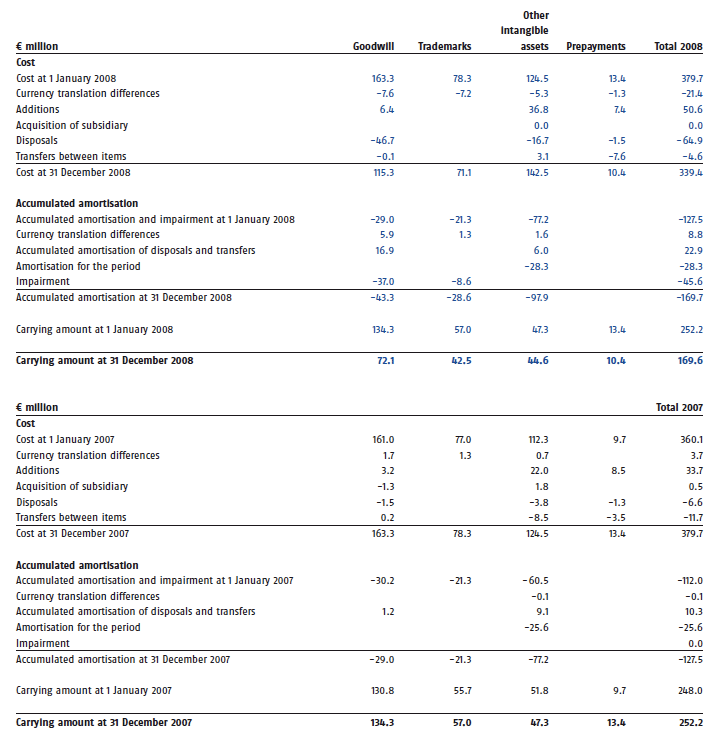Note 12
Intangible assets

Goodwill and intangible assets by segment

Cash-generating units have mainly been identified at a level lower than business segments. The units have been identified by chain/country, which susbstantially corresponds to the legal structure.
The useful lives of trademarks (brands) included in intangible
assets have been classified as indefinite because it has been
estimated that they will affect the generation of cash flows over
an indefinite period. This is because no foreseeable limit to the
period over which they are expected to generate net cash
inflows for the Group can be seen. Trademarks are part of
assets purchased in connection with acquisitions.
Intangible assets with indefinite lives are tested annually for
possible impairment and whenever there is an indication of
impairment.
During the period, Byggsenteret, part of the Norwegian Byggmakker
group, was sold, and the allocated goodwill was €9.5
million.
Impairment test for goodwill and intangible assets
The recoverable amount of a cash-generating unit is determined based on value-in-use calculations. These calculations use cash flow projections based on financial plans approved by the management covering a period of 3–4 years. The key assumptions used for the plans are total market development and profitability, changes in store network, product and service selection and pricing. Cash flows beyond the period are extrapolated using mainly 1–4% growth rates. The discount rate used is the WACC, specifed for each division and country after tax, which is adjusted by tax effects in connection with the test. The WACC formula inputs are risk-free rate of return, market risk premium, industry-specific beta factor, target capital structure, borrowing cost and country risks.
Impairment losses
For the 2008 accounting period, an impairment charge of €45.6
million was made against Byggmakker Norge's (Rautakesko)
intangible assets. Of this amount €37.0 million was allocated to
goodwill and €8.6 million to the trademark, with both amounts
reported as non-recurring items. The impairment loss was due
to weaker-than-expected profitability development. In addition,
it was estimated that revenue expectations concerning
Byggmakker had declined. Byggmakker Norge constitutes a separate
cash-generating unit and it belongs to the Rautakesko
segment.
During the 2007 accounting period, impairment was not allocated
to goodwill and trademarks with indefinite useful lives.
Sensitivity analysis
The key variables used in the impairment test are EBITDA percentage
and discount rate.
The intangible assets relating to the business operations of
Byggmakker and Indoor are the most sensitive to changes in
assumptions. After the impairment recognised on Byggmakker
for 2008, the carrying amount of its assets equals the reassessed
recoverable amount. For Indoor, the reduction of residual EBITDA
of over 0.3%, as well as the 0.4 pp discount rate increase would
cause a need for impairment recognition.
When cash generating units are estimated according to the
management's assumptions, a foreseeable change in any key
variable would not create a situation in which the recoverable
amounts of cash generating units wold be less than their carrying
amounts.